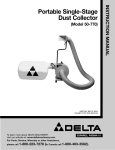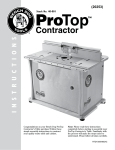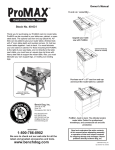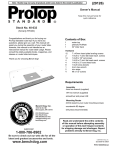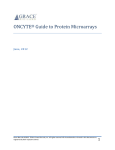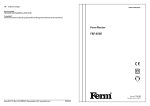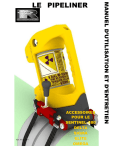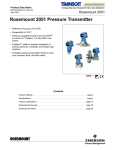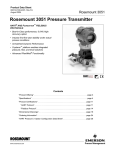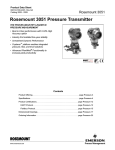Download Bench Dog Tools Phenolic ProPlates Owner`s manual
Transcript
Contents of Box model number RT100 Owner's Manual Congratulations and thank you for buying our router table! If you have any questions, please give us a call. This manual will assist you during the assembly of your router table. However, this manual is not intended as an instructional manual for router table usage. Please consult the widely available books, magazines, and classes on router table techniques. H NC D TO OLS routertop fence phenolic ProPlate, standard 2" bit hole (router insert plate) miter track 12 2 1 2 14 12 10 2 1 1 2 4 Router Table Hardware 1/4-20 x 2" round head bolts for cabinet and top 1/4-20 x 3/4" phil. flat head ms for insert plate 1/4-20 x 1" phil. flat head ms for miter track 1/4-20 x 2" phil. flat head ms for miter track 1/4-20" cross dowels for cabinet and top 7 x 40 mm insert plate leveling screws 1/4-28 x 1/2" set screws for miter track Euro hinges and mounting plates with screws door stop with (1) #7 x3/4" screw nylon handle with (2) #8 x 1-1/8" screws aluminum trim strips for routertop #6 x 1/2" screws for trim strips 1 1 1 1 1 Cabinet Panels left side panel back panel with cord cut-out right side panel base panel door panel 2 2 2 2 6 4 1 1 2 2 2 Fence Hardware/Accessories 3/8-16 x 3" carriage bolts for fence mounting 3/8" nylon handle spacer washers 2-1/2" t-bar knobs for fence mounting 1/4-20 x 3/4" hex bolts for bit guard mounting 1-1/8-1/4" knobs for sub-fence and guard mounting 1/4" x 40mm shoulder bolts for subfence mounting dual position bit guard dust port (slides into fence) MDF subfences aluminum knob spacers aluminum jointer bars (pair) Tools Required OG BE Thank you for choosing Bench Dog! 1 1 1 1 Bench Dog, Inc. 3310 5th St. NE Suite 100 Minneapolis, MN 55418 612.782.8205 main 612.788.2518 fax 800.786.8902 toll free [email protected] www.benchdog.com Assembly Symbols 4 mm Allen wrench (supplied) ! Warning 1/8" Allen wrench (supplied) I Important screwdriver and power drill Mounting Router drill bit (sized to your router) countersink 82 degree drill press (recommended) QUESTIONS? 1-800-786-8902 Be sure to check out our web site for all the latest and greatest accessories and tools. www.benchdog.com Read and understand the entire contents of this manual before attempting assembly or operation of this tool! Inspect contents for shipping damage and shortages. Report problems directly to Bench Dog, Inc. 2002 Bench Dog, Inc. 82-0007-01 1102 General Conditions and Limited Two Year Warranty We make every effort to assure that our products meet quality and durability standards, and warrant to the original retail purchaser that this product is free from defects in materials and workmanship for two years. Remedy shall be limited to Bench Dog's choice of repair, replacement or refund. This warranty does not provide remedy for consequential economic loss. This is a limited two year warranty. It requires the purchaser to contact Bench Dog in writing within 30 days of discovering the defect. Warranty does not apply to defects due directly or indirectly to misuse, abuse, negligence or accidents, repairs or alterations, or due to lack of maintenance. It excludes components and parts not manufactured by Bench Dog, defects caused by failure to provide a suitable installation environment, and damage caused by use for purposes other than those for which the product was designed. Bench Dog, Inc. reserves the right to make product changes without notice and without obligation to make these changes on products previously sold. Important Safety Points Before operating your router table please read this manual thoroughly. Safety and use tips are contained in the manual. This page is not the sole source of safety information. Retain the manual for future reference. Refer to your router owner's manual for safety instructions regarding use of that tool. This manual is not an instruction book on how to do woodworking with a power tool. We encourage all woodworkers to continually seek improvement in their woodworking skills, regardless of their craftsmanship or years of experience. The router table, fence and accessories must only be used for their intended purpose: woodworking via normal routing operations. “Normal operations” means basic shaping of wood in conditions where grounded electricity, sharp tools, dust, and rapidly spinning parts can be used or encountered safely. The following instructions elaborate on this concept. 1. 2. 3. 4. 5. 6. 7. 8. 9. 10. 11. 12. 13. 14. 15. Do not use your router table as a step or seat. The top and cabinet must be properly secured, and be level before use. Inspect your table and base for damage and levelness prior to each use. Keep work area clean, dry and well lit. The hardware affixing the insert to the routertop must be installed for safe use. Tighten insert hold-down screws before each use. Safe operation requires a router table fence, bit guard, dust collection system, starting pin or fulcrum, and speed reducer for large diameter bits. We recommend reducing router speed for 1" or larger diameter bits. Consult your bit manufacturer for the exact speed. Use the right tool for the job. Do not force a tool or attachment to do a job for which it was not designed. Secure your work with a featherboard, clamps, or a vice when appropriate. The use of inappropriate accessories may cause injury. Wear safety glasses, dust mask, face shield and ear protection. This is not an exhaustive list. Every-day eye glasses do not substitute for safety glasses. Do not wear gloves or jewelry while using a power tool and ProTop. Maintain your equipment and its accessories in good working condition. Look for wear, poor alignment of moving parts, binding of moving parts, breakage, poor mounting, or other conditions that may affect operation and safety. Repair or replace any damaged parts. Disconnect the power before moving, adjusting, or repairing parts, or otherwise maintaining your router table and any accessories you may be using. Keep children, pets, and those who may disregard safety away from work area, cords, sockets and tools. Wear snug fitting clothes and keep long hair back to avoid catching in moving parts. Do not overreach. Maintain balanced footing and stance. Stay alert. Use common sense. In any correspondence with Bench Dog, Inc., please refer to the date and place of purchase. You may reach us at Bench Dog, Inc. 3310 5th St.. NE, Suite 100, Mpls., MN 55413 USA, (612) 782-8205 or 1-800-786-8902. On the internet, you may reach us at www.benchdog.com. Page 2 Assembly Instructions 1 1. Attach the Euro hinges to the door as shown. Press the hinge cups into their bores. Turn the integral hinge cams to tighten. (cabinet inside) cup holes for hinges Door door handle holes 2. Attach the hinge mounting plates to the left side cabinet panel. Note the orientation in the photo. The hinge resembles the letter "t". Locate the top of the "t" nearest the front edge of the side panel as shown in the photo. Make sure the spring loaded release lever faces the back edge of the cabinet. Spring loaded release lever Left Side (top) (cabinet inside) Front Edge of Cabinet 2 Top of "T" mounting plate. holes for hinge mounting plates cross dowel holes Front edge of cabinet 3. Attach the plastic door stop to the right side cabinet panel. Use the small #7 x 3/4" silver colored wood screw. Right Side (top) Door stop detail 3 (cabinet inside) plastic door stop hole 4. Attach left and right side panels to the back panel. Do not install the panels upside down. Position the cord cut-out to the bottom right. Use the 1/4-20 x 2" round head bolts and cross dowels, and the supplied 4mm wrench to tighten the bolts. The cross dowels may fit tightly into their holes. Tap them in with a hammer if necessary. The drawing below shows how these strong but simple fasteners fit together. 1/4-20" cross dowel 4 Bolt Panel Cross Dowel 1/4-20 x 2" round head bolt Panel Page 3 5. Attach the cabinet base panel. Flip the cabinet over, as shown. Use the same 1/4" round head bolts and cross dowels as above. When done, flip the unit right side up. Note: the bottom side of the cabinet base panel has counter bored holes to accept the bolt heads. 5 6. Install the (12) leveling screws (for the insert plate). Place the routertop face down, as shown. Use a power drill, and drive the screws in until they barely come through the other side. You will fine adjust them in step 11. Some cracking of the laminate's color layer may occur, but this will not affect the product's performance. 6 ! 7 x 40mm leveling screw Drive the leveling screws into the (12) small holes. Be careful not to drive a leveling screw into the two larger insert holes! 7. Attach the (2) aluminum trim strips to the routertop. Use the (4) small #6 x 1/2 screws. Use a phillips screwdriver and install by hand. Be careful not to over tighten the screws. Do not use a power drill in this step! The trim strips are purely decorative. Position the trim strip as shown, and drive the screws into the bottom of the routertop. ! Drive the screws into the bottom of the routertop, not into the side of the routertop! 7 8 8 Attach the routertop to the cabinet. Use (3) of the same 1/4" round head bolts and cross dowels as used earlier. Attach the routertop to the cabinet sides and back panel. Page 4 9. Attach the miter track to the routertop. First install (2) 1/4" cross dowels in the cabinet side panels. The center miter track screw attaches to a factory installed insert. Use the (2) 1/4-20 x 2" phil. flat head machine screws in the outside track holes. The center track hole uses the 1/4-20 x 1" phil. flat head machine screw. 9 1/4-20 x 1" phil. flat head machine screw 1/4-20 x 2" phil. flat head machine screw 10. Adjust the miter gauge track to fit your miter gauge. Begin this step by first test fitting your miter gauge for fit. If it fits too tightly, lightly squeeze the gib towards the front edge of the track to open it wider. Protect the edges with a cloth. Next, install the (12) 1/4-28 x 1/2" set screws into the track. The screws tighten the miter track by deflecting the gib. Tighten all the screws uniformly and gradually until desired fit is achieved. Use the supplied 1/8" Allen wrench. The slot is designed to fit your standard 3/4 x 3/8" miter gauge bars. Use the "t" slot to mount accessories. (It's the smaller slot, and accepts 1/4" hex bolts). Wax the track and bar to prevent undue wear! 10 I Note: you may have extra set screws. 11 11. Adjust the leveling screws until the insert is flush. First, remove the protective paper from your acrylic router insert plate, and drop it into the routertop opening. Here, the user is checking flushness with his right hand while adjusting the leveling screws with his left. Fine adjust the six screws at the four corners of the insert opening first. Then, adjust the remaining screws. I Important! In step 18 you will mount your router to the insert plate. After that, you may again need to fine adjust the plate's flushness. 12 12. Attach the nylon door handle. Use the (2) #8 x 1-1/8" screws, as shown. #8 x1-1/8" screw Page 5 13. Clip-on the door and adjust the hinges if necessary. If your hinges do need adjustment, see below. Please, take your time to figure out how the hinges clip on. You'll get the hang of it soon enough! Our "Euro" style hinges are strong, self-closing, and clip on and off. Note, removing the door makes clamping to the leading edge of the routertop easier. However, keep the door installed to cut down on dust and router noise. Lateral Adjustment Screw Frontal Adjustment Screw ! 13 Vertical Adjustment Screws Don't force the hinges onto the mounting plates! 14. Install the dust port. Pull the port along the two grooves extruded into the fence until it snaps into place in the center bit opening area. The port will fit tightly. 15. Install the (2) MDF subfences onto the fence. Use the (4) 1/4-20 x 40mm shoulder bolts and t-knobs. The subfences have no left/right or up/down designation. The bolts are designed to fit snugly into the subfences to prevent the heads from spinning. Light finger pressure on the head of the bolt may be necessary. The bolt heads must recess into the subfence counter bores. 14 15 1/4-20 x 40mm shoulder bolt 16. Attach the fence to the routertop. Use the (2) 3/8-16 x 3" carriage bolts, (2) aluminum knob spacers, (2) 3/8" nylon handle spacer washers, and (2) large t-knobs. The bolts enter from inside the cabinet. To adjust the fence, simply loosen both fence knobs until the fence slides smoothly. The fence does not have to remain parallel to the front edge of the router table unless you use it in conjunction with a miter gauge. Loosening just one knob and pivoting the fence is an effective way to attain fine adjustments. fence clamp handle handle spacer 3/8" nylon handle spacer washer routertop Page 6 3/8-16 x 3" carriage bolt 16 17. Attach the dual position bit guard to the fence. Use the (2) 1/4-20 x 3/4" hex bolts and knobs. The bolt heads slide into the t-slots on the fence. These t-slots capture the bolt heads to prevent their turning. The guard in the photo is positioned for general routing. The other end of the guard is used for jointing and smaller diameter bits. Always use your bit guard! 17 1/4 x 3/4" hex bolt 18 18. Mount your router to the ProPlate. Go to the Router Mounting Appendix now. 19. Install the (2) insert plate hold-down screws. The (2) 1/4-20 x 3/4" phil. flat head machine screws prevent side to side movement, as well as keep the plate firmly seated. Over tightening the screws may deform the plate. Readjust the plate flush if necessary. Tighten the holddown screws before every use, if necessary! 19 1/4 x 3/4" phil. flat head machine screw Basic Operations *Router not included. Typical Set-up Feed Direction Always feed your stock against the cutter rotation, as shown. If you feed your stock with the cutter rotation you are climb cutting. Climb cutting is VERY dangerous because the router bit can grab the stock from under your hands and throw it at great speed. Even small diameter router bits can overpower your ability to hold onto the stock. Do not attempt to use the router table until you understand that you feed your stock into the cutter rotation. If you're still unclear, ask your retailer for help, give us a call, or study router table techniques with a book or in a class. ! Routertop Bit Rotation Fence Stock Feed Direction! Never Climb Cut! Page 7 Jointing Jointing is the process of making two flat, square, and straight mating edges. Jointing is usually done before two boards are glued together. It is also used to "fit" pieces together, as well as to trim stock to size. Jointing on the routertop is not designed to replace a free standing power jointer. However, jointing with your router table has advantages over other methods. First, small and short pieces of wood can be safely jointed because the throat opening is also small: about 1/2". Second, the quality of the cut is better than the typical jointer because the router bit spins much faster. This is especially useful on woods prone to tear-out, like curly or burled woods. In this photo, the user is sliding the second bar into position. Your fence has built-in jointing slots to accept the (2) small aluminum jointer bars shipped with your fence. Installed in Here, the jointer bars are pairs, these bars "shim out" the out feed subfence either mounted in slots 2 and 4. 1/32" or 5/64" (2mm). The instructions below are Slots 1 and 3 = 5/64" (2mm Cut) specific to setting up your fence for jointing. 1 2 Slots 2 and 4 = 1/32" Cut 1. Install a 1/2" diameter straight or spiral up-cut bit in your router. Use only 1/2" shank bits. The bit's cutting length Note the small "v" grooves. must not exceed 1". Set the height to 1" or less. 4 2. Loosen the outfeed subfence mounting knobs and slide both bars (always installed in pairs!) under the outfeed subfence in either the 2nd and 4th slots, or the 1st and 3rd. See the upper right illustration. 3. Use a straight edge to adjust the router bit and outfeed subfence to the same plane. Tighten the fence clamping knobs. Readjust if needed. Remove straight edge when done. 4. Slide both sub fences towards the bit to decrease the amount of gap between the subfences and router bit. Confirm that the subfences are not touching the router bit. Tighten the subfence knobs, and position the bit guard. Plug-in your router and begin. 3 outfeed subfence If board "snipe" occurs, realign the out feed subfence to the router bit. Don't be surprised if it takes you one or two tries to master this operation. snipe (Bit guard not shown for clarity, only!) fence (top view) jointer bars outfeed subfence router bit infeed subfence straight edge - remove before jointing!!! Stock (wood) ! Always use a push stick or pad when jointing! Page 8 Outfeed subfence and router bit are set to the same plane! Feed Direction Adjusting the Subfences The (2) MDF (medium density fiberboard) subfences are designed to slide along the fence approximately 2". This results in a router bit opening from 0" to 4". Adjusting the subfences into the routerbit profile produces "zero clearance". Essentially, zero clearance eliminates the gap between your fence and the router bit, the major reason your stock gets sucked into the fence just before the router bit. Moreover, less chip-out occurs because the subfence supports the fibers of the wood stock you are cutting. A. "Close" Setting In many instances, adjusting the subfences close to the router bit is all that is necessary, and accomplishes about the same thing as a true zero clearance setting. Before the router is turned on, and after the fence and router bit height are properly adjusted, simply slide the subfences towards the bit to reduce the gap. After setting the subfences close to the bit, make absolutely sure the router bit can freely move without running into the subfences before turning on the router! B. "Zero Clearance" Setting If a true zero clearance setting is desired, follow the instructions below. 1. Set the bit height and fence where you need them. Confirm that the bit, router, insert holddown screws and fence are properly set and secure. along the same plane. Final router bit height must be set! At this point the subfences must not touch the router bit. Router Bit Guide Bearing Outfeed Subfence Infeed Subfence Bit Outfeed Subfence In this drawing, above, the infeed subfence is not set to zero clearance. Infeed Subfence Bit In this drawing, above, the infeed subfence is set to zero clearance. Important Notes: The outfeed subfence is almost never set to zero clearance because a "close" setting usually works just fine. Setting the outfeed subfence to zero 2. Install the bit guard. clearance requires great care because the router bit can cause a portion of the outfeed subfence to chip3. Connect your vacuum to the dust port. out or break. Therefore, if you must use zero 4. Start the router. From the back of the clearance, slide the subfence very slowly into the fence, slightly loosen the subfence knobs until the bit to minimize these affects. Otherwise, just set the subfence can move. Carefully slide the infeed subfence outfeed subfence close to the bit. towards the router bit. Hold onto the subfence knob as shown in the photo above. Never push the subfence with your hands on the face of it. 5. When the infeed subfence has stopped on the routerbit's guide bearing, fully tighten the subfence knobs and proceed with your operation. If your bit has no guide bearing, (e.g., vertical raised panel bits), slide the subfence half-way into the bit. Tighten the knobs. Zero clearance has been achieved. Flip the subfences when you change bit profiles or heights. Purchase new subfences when all ends are wasted, and when the ends cannot be trimmed to provide a fresh edge. MDF works perfectly as a subfence because it is softer than most woods, and is much kinder on delicate profiles. Razor edges remain after producing lock miter and other profiles. When adjusting the fence, ensure that no part of the aluminum will be in the zone of contact with the router bit. Page 9 Fence Traps Fence traps occur whenever the work piece is fully "trapped" between the router bit and the fence. Fence traps pose two real problems: the possibility of climb feeding, and exposure to the router bit. As you've read earlier, you absolutely want to avoid climb cutting, because you may lose control of the operation. The top drawing shows a classic trap. What may appear to be the normal feed direction (working from right to left) will instead result in a climb cut. And, because the work is also trapped, it will surely be grabbed from your hands, and thrown with great speed. If instead you feed the stock from left to right, you will not be climb cutting. However, this doesn't overcome the other problems that come with a trap. First, it will be difficult to keep the stock tight against the fence, as the bit's rotation will tend to thrust the stock away from the fence. Secondly, your body will be dangerously exposed to the router bit. The factory bit guard will not protect you against flying stock. The next drawing is not a classic trap, as long as the router bit cuts only partially into the stock! In this cut, the forces will tend to grab and push the stock toward the fence. This is good. The fence will control the force better than your hands. Typical dado-type cuts resemble this set up, and are commonly performed with router tables. If you widen the dado with a second pass, be careful not to set a classic trap or a climb cut. Fence Stock NO! b it r o t a ti o n Classic Trap! Fence b it Stock r o t a ti o n Not a trap. Temperature Regulation There are several preventative measures to reduce the chance of your router overheating during long periods of use. Two basic methods are to periodically open the cabinet door during use, and to use an adequate vaccuum source in conjunction with the fence mounted dust port to insure circulation. Another option is to install a second dustport to the cabinet for added air ciculation and dust control. Dust Collection Your fence has built-in dust collection. The dust port is designed to fit standard 2-1/2" shop vac hose (fittings are actually 2-1/4" O.D.). For 1-1/4" vac hose, purchase an adapter. (The larger 2-1/2" vac hose is a better choice.) If necessary, wrap the end of your hose fitting with duct tape for a tighter fit. Three inch or larger hose requires a reducer to 21/2". Then, connect the port to the reducer with a short section of 2-1/2" vac hose. You may choose to add additional dust collection at the cabinet level. Supplies for this are not provided, however. *Hose not included. Using Your Miter Gauge The miter track has two slots: a t-slot and a t-bar compatible miter gauge slot. The t-slot is the narrower of the two. It accepts 1/4" hex bolts for attaching Feather-Loc featherboards and the like. The miter gauge slot is used for your miter gauge. The miter gauge that came with your table saw works well as long at it has a standard 3/4" x 3/8" bar. Page 10 Incorrect feed direction! *Miter gauge not included. Correct feed direction! Bench Dog Accessories ProLift Ni and ProLift Al top adjust router systems ProLift allows you to change your bits above the table without removing the motor or lift - simply use your factory wrenches! ProLift is available in either cast iron or aluminum models and features three bit opening sizes, cooling fins, zeroadjustment from any bit height, and four threaded starting pin locations. Expand ProLift's versatility with one of several accessories. ProLift accommodates fixed base routers only. ProLift Ni accepts 4.2" diameter motors and less - ProLift Al 3.5" diameter and less. p/n PL1001, PL1002. Patents pending. ProLift Ni shown, Router not included. p/n PL1002 Panel-Loc panel cutting handguard / hold-down Panel-Loc is the first combo hand guard and panel hold down for routing panels. The unique aluminum shape and UHMW contact strip places pressure on exactly the right location. It also protects your hands, alleviates chatter, reduces fatigue, and improves results. Includes a special mounting t-track for all fences. p/n PL400. Patents pending Panel-Loc shown on ProTop Complete. p/n PL400 AC C E S S O RY Feather-Loc feather boards Feather-Loc is our four-in-one featherboard with a built-in tension setup feather. On our router tables, Feather-Locs are featherboards, fence stops, table stops, and a starting pin and fulcrum. Feather-Locs mount directly to your table's t-slots p/n FL200. For table saws, use p/n FL100, which includes one featherboard and one 3/4" x 3/8" miter slot 2 pair Feather-Loc adapter. Patents pending. shown on a ProTop complete. p/n FL200 AC C E S S O RY ProPlate insert plates ProPlates are the perfect way to change your router bit hole size. We offer plates with hole sizes from zero to 3.6". ProPlates come in acrylic, phenolic, and aluminum in both predrilled and undrilled styles. ProPlate aluminum features removable insert rings, four starting pin locations, and a supporting line of accessories. No matter what model router you own, Bench Dog has you covered. Undrilled ProPlate aluminum shown. p/n M1001 AC C E S S O RY Fence Riser Option A fence riser option is available for your fence. The function of the riser is to add height to your fence. This gives your work more support during vertical cutting operations. Cutting vertical raised panels is a common task made easier with the riser option. The cutting of dovetails and tenons are other examples. In this photo the user is attaching the MDF fence to the riser brackets. p/n FR400/100. H NC D TO OG BE AC C E S S O RY OLS Please contact us if you have any questions (1-800-786-8902). Be sure to check out our web site for all the latest accessories and tools. www.benchdog.com Page 11











